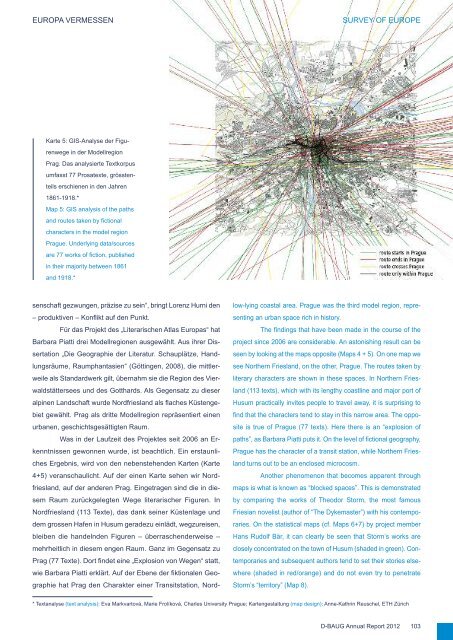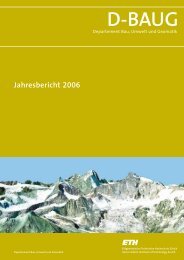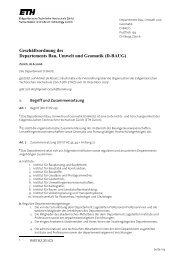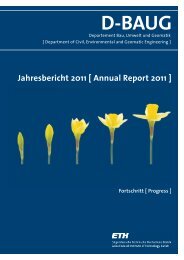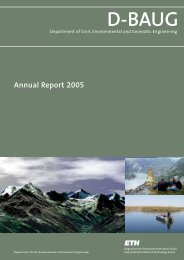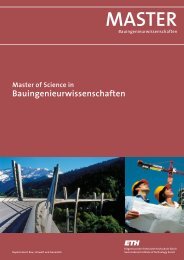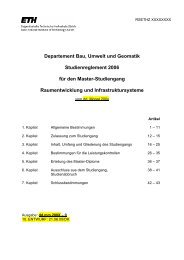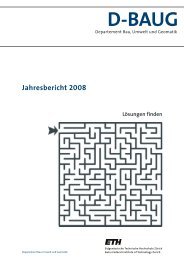Annual Report 2012 - Departement Bau, Umwelt und Geomatik ...
Annual Report 2012 - Departement Bau, Umwelt und Geomatik ...
Annual Report 2012 - Departement Bau, Umwelt und Geomatik ...
- Keine Tags gefunden...
Sie wollen auch ein ePaper? Erhöhen Sie die Reichweite Ihrer Titel.
YUMPU macht aus Druck-PDFs automatisch weboptimierte ePaper, die Google liebt.
EUROPA VERMESSEN<br />
SURVEY OF EUROPE<br />
Karte 5: GIS-Analyse der Figurenwege<br />
in der Modellregion<br />
Prag. Das analysierte Textkorpus<br />
umfasst 77 Prosatexte, grösstenteils<br />
erschienen in den Jahren<br />
1861-1918.*<br />
Map 5: GIS analysis of the paths<br />
and routes taken by fictional<br />
characters in the model region<br />
Prague. Underlying data/sources<br />
are 77 works of fiction, published<br />
in their majority between 1861<br />
and 1918.*<br />
senschaft gezwungen, präzise zu sein“, bringt Lorenz Hurni den<br />
– produktiven – Konflikt auf den Punkt.<br />
Für das Projekt des „Literarischen Atlas Europas“ hat<br />
Barbara Piatti drei Modellregionen ausgewählt. Aus ihrer Dissertation<br />
„Die Geographie der Literatur. Schauplätze, Handlungsräume,<br />
Raumphantasien“ (Göttingen, 2008), die mittlerweile<br />
als Standardwerk gilt, übernahm sie die Region des Vierwaldstättersees<br />
<strong>und</strong> des Gotthards. Als Gegensatz zu dieser<br />
alpinen Landschaft wurde Nordfriesland als flaches Küstengebiet<br />
gewählt. Prag als dritte Modellregion repräsentiert einen<br />
urbanen, geschichtsgesättigten Raum.<br />
Was in der Laufzeit des Projektes seit 2006 an Erkenntnissen<br />
gewonnen wurde, ist beachtlich. Ein erstaunliches<br />
Ergebnis, wird von den nebenstehenden Karten (Karte<br />
4+5) veranschaulicht. Auf der einen Karte sehen wir Nordfriesland,<br />
auf der anderen Prag. Eingetragen sind die in diesem<br />
Raum zurückgelegten Wege literarischer Figuren. In<br />
Nordfriesland (113 Texte), das dank seiner Küstenlage <strong>und</strong><br />
dem grossen Hafen in Husum geradezu einlädt, wegzureisen,<br />
bleiben die handelnden Figuren – überraschenderweise –<br />
mehrheitlich in diesem engen Raum. Ganz im Gegensatz zu<br />
Prag (77 Texte). Dort findet eine „Explosion von Wegen“ statt,<br />
wie Barbara Piatti erklärt. Auf der Ebene der fiktionalen Geographie<br />
hat Prag den Charakter einer Transitstation, Nordlow-lying<br />
coastal area. Prague was the third model region, representing<br />
an urban space rich in history.<br />
The findings that have been made in the course of the<br />
project since 2006 are considerable. An astonishing result can be<br />
seen by looking at the maps opposite (Maps 4 + 5). On one map we<br />
see Northern Friesland, on the other, Prague. The routes taken by<br />
literary characters are shown in these spaces. In Northern Friesland<br />
(113 texts), which with its lengthy coastline and major port of<br />
Husum practically invites people to travel away, it is surprising to<br />
find that the characters tend to stay in this narrow area. The opposite<br />
is true of Prague (77 texts). Here there is an “explosion of<br />
paths”, as Barbara Piatti puts it. On the level of fictional geography,<br />
Prague has the character of a transit station, while Northern Friesland<br />
turns out to be an enclosed microcosm.<br />
Another phenomenon that becomes apparent through<br />
maps is what is known as “blocked spaces”. This is demonstrated<br />
by comparing the works of Theodor Storm, the most famous<br />
Friesian novelist (author of “The Dykemaster”) with his contemporaries.<br />
On the statistical maps (cf. Maps 6+7) by project member<br />
Hans Rudolf Bär, it can clearly be seen that Storm’s works are<br />
closely concentrated on the town of Husum (shaded in green). Contemporaries<br />
and subsequent authors tend to set their stories elsewhere<br />
(shaded in red/orange) and do not even try to penetrate<br />
Storm’s “territory” (Map 8).<br />
* Textanalyse (text analysis): Eva Markvartová, Marie Frolíková, Charles University Prague; Kartengestaltung (map design): Anne-Kathrin Reuschel, ETH Zürich<br />
D-BAUG <strong>Annual</strong> <strong>Report</strong> <strong>2012</strong><br />
103


